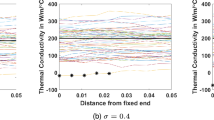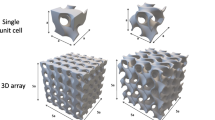Abstract
For steels and aluminum alloys, liquid quenching is the most effective method to achieve fast cooling rates. In the example of water quenching an aluminum 319 cylinder head, the temperature drops rapidly within 30 seconds from solutionizing temperatures at 495 °C to water pool temperature below 100 °C. In this temperature range, the water boiling in the quenching process goes through three boiling regimes, film boiling, transition boiling and nucleate boiling, before reducing to convection heat transfer. Since each boiling regime has unique heat transfer characteristics that are governed by different physics, modeling the water quenching processes by computer simulation requires a heat transfer framework, instead of just a few equations, that can describe all the boiling regimes. Among several heat transfer frameworks found in the literature, we had successes in developing a CFD methodology to simulate the boiling process by adapting a heat transfer framework based on Leidenfrost point (LFP), minimum heat flux (MHF) and critical heat flux (CHF). This CFD methodology, when integrated with FEA structural analysis, is the key enabler for virtual process verification. This is achieved by first calculating temperature histories and profiles in CFD and then applying the temperature data as thermal load to FEA to predict thermal residual stress and distortion. Although the LFP, MHF and CHF framework have been proven useful to model the water quenching process, these parameters are not constants and they have to be calibrated through experiments for each quenching condition. The objective of this paper is to develop a consistent method to calibrate the boiling heat transfer framework using cooling curves obtained by the ASTM D6200 quenchometer. Also included in this paper is a preliminary discussion on broadening the standard in order to support: (1) generic cooling curve characteristics for any quenchant, (2) the analytical cooling curve for computation model calibration.





















Similar content being viewed by others
Abbreviations
- \(\rho\) (\(\rho_{{\rm l}}\), \(\rho_{{\rm v}}\)):
-
Density (liquid, vapor) (kg/m3)
- \(C_{p}\) (\(C_{p{\rm l}}\), \(C_{p{\rm v}}\)):
-
Heat capacity (liquid, vapor) (J/kg °K)
- \(k\) (\(k_{\rm l}\), \(k_{\rm v}\)):
-
Thermal conductivity (liquid, vapor) (W/m °K)
- \(h\) :
-
Heat transfer coefficient (W/m2 °K)
- \(g\) :
-
Gravity (m/s2)
- \(h_{fg}\) :
-
Latent heat for liquid-vapor phase change (J/kg)
- \(D_{0}\) :
-
Length scale for vapor bubble diameter (m)
- \(\sigma\) :
-
Surface tension (N/m)
- \(t\) :
-
Time (s)
- \(V\) :
-
Volume of the metal part (m3)
- \(A\) :
-
Surface area of the metal part (m2)
- \(L\) :
-
Characteristic length of the metal part (m)
- \(T\) :
-
Temperature (°K)
- \(T_{\rm w}\), \(T_{\rm s}\) :
-
Wall temperature (°K)
- \(T_{0}\) :
-
Initial temperature (°K)
- \(T_{\infty }\) :
-
Free stream temperature (°K)
- \(T_{{\rm sat}}\) :
-
Saturation temperature (°K)
- \(\dot{T}\) :
-
Cooling rate (°K/s or °C/s)
- \(q_{\rm b}\), \(q^{\prime \prime }\), \(Q\) :
-
Boiling heat flux (W/m2)
- \(q_{ \hbox{max} }\) :
-
Maximum heat flux (W/m2)
- \(\Delta T_{\rm sat}\) :
-
Temperature difference between wall and saturation temperature (°K)
- \(T_{\infty }\) :
-
Free stream temperature (°K)
- \(H\) :
-
Grossman Number (1/m)
- \({\text{Bi}}\) :
-
Biot number (dimensionless)
- \({\text{Fo}}\) :
-
Fourier number (dimensionless)
- \({\text{Ja}}\) :
-
Jakob number (dimensionless)
- \({\text{Pe}}\) :
-
Péclet number (dimensionless)
References
D.S. MacKenzie, Metallurgy of Heat Treatable Aluminum Alloys, in Heat Treating of Nonferrous Alloys, Vol 4E, ASM Handbook, ASM International, Cleveland, 2016, p 65–113
M.E. Fine, Precipitation Hardening of Aluminum Alloys, Metall. Trans. A, 1975, 6, p 625. https://doi.org/10.1007/BF02672283
S.P. Gupta, Solid State Phase Transformations, Allied Publishers Private Limited, Bengaluru, 2002, p 299–347
G. Wang, J.L. Dossett, and H.E. Boyer, Heat Treating of Carbon Steels, Heat Treating of Irons and Steels, ASM Handbook, vol. 4D, ASM International, Cleveland, 2014, p 99–121
H.D. Alvarenga, T. Van de Putte, N. Van Steenberge, J. Sietsma, and H. Terryn, Influence of Carbide Morphology and Microstructure on the Kinetics of Superficial Decarburization of C-Mn Steels, Metall. Mater. Trans. A., 2014, 46, p 123–133
D.S. MacKenzie, Selection of Oil Quenchants for Heat Treating Processes. Int. Heat Treat. Surf. Eng., 2014, 8, p 8–14. https://doi.org/10.1179/1749514813Z.00000000089
E. Troell, H. Kristoffersen, J. Bodin, and S. Segerberg, 12.04-Controlling the Cooling Process—Measurement, Analysis, and Quality Assurance. Compr. Mater. Process., 2014, 12, p 99–121. https://doi.org/10.1016/B978-0-08-096532-1.01204-8
Dossett, J.L., and Totten, G.E., Steel Heat Treating Fundamentals and Processes, ASM Handbook, vol. 4A. ASM International, Cleveland, 2013. https://doi.org/10.31399/asm.hb.v04a.9781627081658
Jan, J., and Nannapuraju, M, CFD Investigation of Quench Media and Orientation Effects on Structural Stress Induced in the Intense Quenching Processes for Aluminum Cylinder Heads, in ASM 29th Heat Treating Society Conference and Exposition, Columbus, 2017
M. Koc, J. Culp, and T. Altan, Prediction of Residual Stresses in Quenched Aluminum Blocks and Their Reduction through Cold Working Processes. J. Mater. Process. Technol., 2006, 174(1), p 342–354
Kaymak, Y., Simulation of Metal Quenching Processes for the Minimization of Distortion and Stress. Ph.D. Dissertation, Fluid Mechanics and Thermodynamics Institute, Otto-van-Guericke University, Magdeburg, 2007
C. Heming, H. Xieqing, and W. Honggang, Calculation of the Residual Stress of a 45 Steel Cylinder with a Non-Linear Surface Heat Transfer Coefficient Including Phase Transformation During Quenching. J. Mater. Process. Technol.89, p 339–343
S. Sen, B. Aksakal, and A. Ozel, Transient and Residual Thermal Stresses in Quenched Cylindrical Bodies. Int. J. Mech. Sci., 2000, 42(10), p 2013–2029
Freborg, A., Li, Z. and Ferguson, L., Modeling Heat Treatment for Characterizing Distortion, Residual Stress, Loading Response and Fracture in a Vacuum Carburized and Gas Quenched Steel Coupon, in Proceeding from 5th International Conference on Thermal Process Modeling and Computer Simulation, Orlando Florida, 2014.
V. Srinivasan, K. Moon, D. Greif, D.M. Wang, and M. Kim, Numerical Simulation of Immersion Quench Cooling Process: Part I, Proceedings in the International Mechanical Engineering Congress and Exposition, IMECE2008, Paper no: IMECE2008-69280, Massachusetts, Boston, 2008
V. Srinivasan, K. Moon, D. Greif, D.M. Wang, and M. Kim, Numerical Simulation of Immersion Quench Cooling Process: Part II, in Proceedings in the International Mechanical Engineering Congress and Exposition, IMECE2008, Paper no: IMECE2008-69281, Massachusetts, USA, Boston, 2008
V. Srinivasan, K.M. Moon, D. Greif, D.M. Wang, and H.M. Kim, Numerical Simulation of Immersion Quench Cooling Process Using Eulerian Multi-Fluid Approach. Appl. Therm. Eng., 2010, 30, p 499–509
Jan, J., Prabhu, E., Lasecki, J., and Weiss, U., Development and Validation of CFD Methodology to Simulate Water Quenching Process, in Proceedings of the ASME 2014 International Manufacturing Science and Engineering Conference, Detroit Michigan, 2014
A. Kaynar, U. Weiss, E. Prabhu, and J. Jan, Experimental and Numerical Investigation of Water Quench Cooling of Aluminum Cylinder Heads, in Proceeding from 5th International Conference on Thermal Process Modeling and Computer Simulation, Orlando, Florida, 2014
J. Jan, R. Kopun, E. Probhu, and D. Greif, On the Investigation of Cooling Rate Influenced by Neighboring Objects in Cluster Quenching Using New Approach in Meshing Technology and Multiphase Flow Solver, NAFEMS European Multiphysics Conference, Denmark, Copenhagen, 2016
J. Walker, Boiling and the Leidenfrost Effect. Fundam. Phys., 2010, p E10-1
C.E. Bates, Selecting Quenchants To Maximize Tensile Properties And Minimize Distortion In Aluminum Parts. J. Heat. Treat., 1987, 5(1), p 27–40. https://doi.org/10.1007/BF02831618
T. Lyman, Metals Handbook of 1948 Edition, The American Society for Metals, Cleveland, 1948
J. Feldman, Solution of the Heat Equation by Separation of Variables, in Lecture Note of Math 267, Department of Mathematics at the University of British Columbia, https://www.math.ubc.ca/~feldman/m267/heatSln.pdf.
Y.A. Cengel, Heat Transfer: A Practical Approach, Mcgraw-Hill, New York, 2002, p 210
A.V. Reddy, D. Akers, M.A. Pershing, and R.A. Woldow, Simple Method Evaluates Quenches. Heat Treat. Progress, 2001, 13, p 40–42
J.D. Bernardin, and J. Mudawar, The Leidenfrost point: experimental study and assessment of existing models. J. Heat Transf., 1999, 121(4), p 894–903
J. Jan, D.S. MacKenzie, On the Characterization of Heat Transfer Rate in Various Boiling Regimes Using Quenchometers and Its Application for Quenching Process Simulations, in Thermal Processing in Motion 2018—Conference Proceedings of the Thermal Processing in Motion, June 5–7 2018, Spartanburg, SC, USA
AVL FIRE User Manual, “Eulerian Multiphase”, Chapter 3, Section 3.1.3.1.4 Quenching Model, AVL-Advance Simulation Technologies
L.A. Bromley, Eat Transfer in Stable Film Boiling. Chem Eng. Progress, 1950, 46, p 221
N. Zuber, Hydrodynamic Aspects of Boiling Heat Transfer, USAEC Report, AECU-4439, 1959
P.J. Berenson, Film Boiling Heat Transfer from a Horizontal Surface. ASME J. Heat Transf., 1961, 83, p 351–356
N. Zuber, On the Stability of Boiling Heat Transfer. Trans. ASME, 1958, 80, p 711
T.C. Hua and J.J. Xu, Quenching Boiling in Subcooled Liquid Nitrogen for Solidification of Aqueous Materials. Mater. Sci. Eng. A, 2000, 292, p 169–172
D.M. Wang, A. Alajbegovic, X.M. Su, and J. Jan, Numerical Modeling of Quenching Cooling Using Eulerian Two-Fluid Method, in Proceedings of ASME International Mechanical Engineering Congress and Exposition, Nov 17–22 2002, New Orleans, Louisiana
D.M. Wang, A. Alajbegovic, X. Su, and J. Jan, Numerical Simulation of Water Quenching Process of an Engine Cylinder Head, in FEDSM2003-45538, 4th ASME-JSME Joint Fluids Engineering Conference, July 6–10 2003, Honolulu, Hawaii, USA
B. Liscic and G.E. Totten, From GM Quenchometer via Cooling Curve Analysis to Temperature Gradient Method, in Heat Treating 1998: Proceedings of the 18th Conference, 1998
ivf SmartQuench-quenchometer, Swerea IVF, Sweden, https://www.swerea.se/en/areas-of-expertise/manufacturing-processes/heat-treatment/ivf-smartquench-equipment.
ASTM D6200-01, Standard Test Method for Determination of Cooling Characteristics of Quench Oils by Cooling Curve Analysis. ASTM Int, 2017. https://doi.org/10.1520/D6200-01R17
Author information
Authors and Affiliations
Corresponding author
Additional information
Publisher's Note
Springer Nature remains neutral with regard to jurisdictional claims in published maps and institutional affiliations.
Rights and permissions
About this article
Cite this article
Jan, J., MacKenzie, D.S. On the Development of Parametrical Water Quenching Heat Transfer Model Using Cooling Curves by ASTM D6200 Quenchometer. J. of Materi Eng and Perform 29, 3612–3625 (2020). https://doi.org/10.1007/s11665-020-04803-z
Received:
Revised:
Published:
Issue Date:
DOI: https://doi.org/10.1007/s11665-020-04803-z




